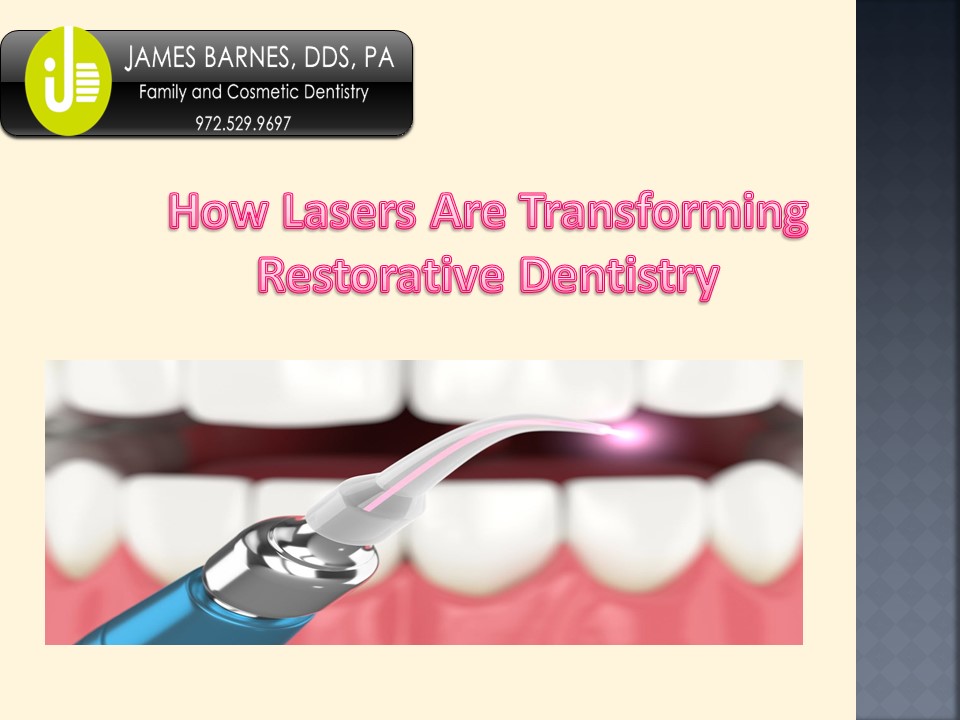How Lasers Are Transforming Restorative Dentistry - PowerPoint PPT Presentation
Title:
How Lasers Are Transforming Restorative Dentistry
Description:
Dr. Barnes, a native Texan, grew up in El Paso, Texas. After graduating from high school, he attended Baylor University in Waco where he received a Bachelor of Arts degree in Biology. He later went on to earn his Doctor of Dental Surgery degree from Baylor College of Dentistry in Dallas, Texas. – PowerPoint PPT presentation
Number of Views:3
Title: How Lasers Are Transforming Restorative Dentistry
1
How Lasers Are Transforming Restorative Dentistry
2
- James Barnes DDS
- Dr. Barnes, a native Texan, grew up in El Paso,
Texas. After graduating from high school, he
attended Baylor University in Waco where he
received a Bachelor of Arts degree in Biology.
He later went on to earn his Doctor of Dental
Surgery degree from Baylor College of Dentistry
in Dallas, Texas. - Dr. Barnes is a member of the American Dental
Association, the American Academy of Cosmetic
Dentistry, the Texas Dental Association and The
North Texas Dental Society. His commitment to
continuing education, use of state of the art
technology, and a genuine compassion for his
patients has enabled Dr. Barnes to provide
exceptional care in a relaxed and friendly
environment.
3
- Our Services
- Family Dentistry
- Cosmetic Dentistry
- Cleanings Exams
- Teeth Whitening
- Dental Implants
- Porcelain Veneers
- Cosmetic White Filling
4
- About
- Lasers were first used commercially in clinical
dental practices in 1989. Since then, laser
dentistry has become a popular treatment solution
for several dental procedures involving hard and
soft tissues, offering an alternative to drills
and other traditional tools. - Are you thinking about getting dental laser
treatment? Heres what you need to know about how
lasers are transforming restorative dentistry.
5
- What Is Laser Dentistry?
- LASER is short for Light Amplification by the
Stimulated Emission of Radiation. In laser
dentistry procedures, the laser device creates
light energy in a narrow and concentrated beam.
When the light hits the target tissue, it
produces a reaction that allows it to shape or
remove tissue. - All lasers (both soft tissue and hard tissue
lasers) work by delivering energy in the form of
light. When used for surgical dental procedures,
the laser acts as a cutting instrument and
removes tissue that it comes in contact with. In
the case of teeth whitening procedures, the laser
acts as a source of heat that enhances the
efficacy of tooth-bleaching agents.
6
- Are Dental Lasers Safe?
- Safety is a common concern for most people who
are considering laser treatment for the first
time. It is important to note that the U.S Food
and Drug Administration (FDA) has approved lasers
sold in the United States. - However, no laser treatment has a Seal of
Acceptance from the American Dental Association
(ADA). That said, the ADA states that it is
cautiously optimistic about the role of laser
technology in dentistry. Additionally, dentists
undergo specific training for each dental laser
device. Therefore, be sure to confirm that your
dentist has the necessary training to operate the
laser device for your specific dental procedure.
7
- Uses of Laser in Restorative Dentistry
- Laser dentistry encompasses treatments for
several oral health issues. Laser dentistry is
used in a variety of procedures, including - Reshaping gum tissue
- Removing tissue around an exposed wisdom tooth
- Extracting inflamed gum tissue
- Taking away small amounts of tooth enamel
- Eliminating muscle attachments that restrict
tongue or lip movement - Repairing certain worn down fillings
- Repairing tooth enamel for composite bonding
- Accelerating in-office tooth whitening procedures
8
- What Are the Pros and Cons of Using Lasers in
Dentistry? - Pros
- Many patients find dental visits nerve-racking
due to the drilling sound associated with many
dental procedures. Because laser dentistry tools
are generally quieter than traditional treatment
options, they may provide a more comfortable
experience for patients who are uncomfortable
with dental drills. In addition, dental lasers - May result in less pain and thus reduce the need
for anesthesia. - May help ease dental anxiety.
- May promote healthier teeth during cavity
removal. - Can reduce bleeding and swelling during soft
tissue treatments.
9
- Cons
- Although lasers have been widely accepted as a
positive advancement in dental treatments, they
have some shortcomings. For example, dental
lasers - Cannot be used on teeth that already have
fillings. - Do not completely eliminate the need for
anesthesia. - May be more expensive than traditional treatment
options. - Cannot be used in many common dental procedures,
such as filling cavities between teeth or
preparing large cavities for crowns. - May require the use of traditional drills to
shape and finalize certain restorative
treatments, such as fillings.
10
Conclusion Although laser treatments will not
completely replace traditional dentistry, their
use has greatly increased the number of treatment
options available to dentists and patients alike.
If you have any questions regarding the use of
lasers in restorative dentistry, talk to your
dentist to learn more.
11
Thank You































